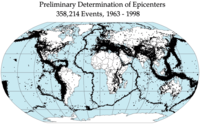
Photo from wikipedia
Porosity is one of the most basic physical properties of a stratum. Previous studies have shown that porosity generally decreases with depth. There are five main types of empirical models… Click to show full abstract
Porosity is one of the most basic physical properties of a stratum. Previous studies have shown that porosity generally decreases with depth. There are five main types of empirical models available for describing such a porosity–depth relationship: the linear model, the exponential model, the power law model, the reciprocal model, and the parabolic model. For the majority of past and existing studies, each tends to focus on one study area, and thus does not present enough data to cover a large depth range and represent the general attenuation of porosity through Earth’s crust. Whether those models can deal with a larger depth scale or not remains unknown. This paper proposes a new empirical porosity–depth model that can describe the decrease of porosity through the entire Earth’s crust. Porosity–depth data are collected from the literature and the proposed model fits the data very well. The model improves the agreement between calculated and measured porosity values and can be used to describe the porosity–depth relationship for continental crust, oceanic crust, sedimentary rocks, and unconsolidated sediments. The proposed model tends to slightly overestimate the measured data for Earth’s continental crust in the depth range of 5–15 km. It is also difficult for a model to fit the near-surface porosity data well for unconsolidated sediments. This study improves the usefulness of the empirical models in estimating porosity where measured data are unavailable, in discerning abnormal strata, and in supporting regional groundwater studies.
Journal Title: Hydrogeology Journal
Year Published: 2020
Link to full text (if available)
Share on Social Media: Sign Up to like & get
recommendations!